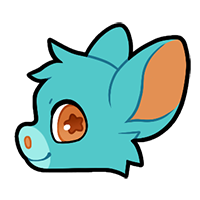Traits
Dark Sclera (Notable)
In some animals the protective layer on their eyes is a darker color, possibly even black in appearance. This adaptation is theorized to hide eye movements in predators or even act as 'gaze camouflage' for social species hiding where they may be looking from others around!
Bright Pupils (Notable)
In some Xeros, the tapetum lucidum that gives them such excellent low-light vision undergoes a dramatic mutation. Bright pupils are the result of this highly reflective tissue, causing it to reflect in such a manner to create this striking appearance! This trait allows a Xero's pupils to be lighter in color than the iris (the main colored part of the eye). The bright pupils can be any color, so long as they are lighter in value than the iris.
Slit Pupils (Standard)
Some Xeros may have thin, slit pupils instead of the standard round or oval ones. This is an uncommon adaptation, but the Xeros that have this style of eye tend to have even stronger night vision.
Hollow Eyes (Hollow)
Life in a world of little-to-no light can present several obstacles, arguably the most important being how to sense the enviroment. Hollow Xeros have developed eyes that feature significantly larger pupils and a highly efficient tapetum. These features enable them to operate effectively in the darkest of conditions and give their eyes a soft, reflective sheen.
Horizontal Pupils (Seasonal)
Though it's very rare, some Xeros may have horizontal pupils instead of the standard round or oval ones. This strange adaptation gives the Xero a wider field of view, making them very hard to sneak up on.
Shaped Pupils (Glitched)
While Xeros typically feature a static pupil, their flexible biology can be manipulated to overcome this limitation. By altering the smooth muscles of the eye, the collarette can be reshaped effectively, changing the shape until desired.
Eye Stalks (Glitched)
Eye stalks are classified as two protrusions from the head of a Xero that have a cone-like base and two round eyes on top. These stalk eyes are simple ocelli and are primarily used to detect light, dark, and movement all around the Xero, rather than complex shapes or colors. Sneaking up on a Xero with this trait would be very difficult!
Eye stalks must be placed on top of the Xero's head area and must be in pairs, much like adding any other extra body part. The eyes must also match the iris and pupil color of the rest of the eyes on the Xero, meaning that if a Xero has blue irises, the stalks must follow suit!
How To Use This Trait
 Do
Do
-
This trait must be placed on the Xeros head area and cannot be placed anywhere else.
-
Much like any extra body parts, eye stalks must be placed in pairs.
-
Eye stalks can be added 2x with Glitch Vials for a maximum of 4 eye stalks.
-
Eye stalks count as extra eyes, and any Xero that has more than 4 eyes total may be censored on the Masterlist. For example a Xero with 4 main eyes and 2 eye stalks would have 6 eyes total, or a Xero with 2 main eyes and 4 stalk eyes.
-
The eye stalks must match the iris and pupil color of the other eyes on the Xero.
-
Eye mutations such as slit pupils may be present on the other eyes of the body but do not need to be added to the stalked eyes.
-
If your Xero has an eye mutation it is no extra cost to add it to your eye stalks.
 Don't
Don't
-
The eye stalks must be placed close together in pairs much like a snail's eyes, placing one "hidden" while the other is prominent is not allowed.
-
The eyes on the top of the eye stalks are small and form on top of the base cones, huge eyes that weigh down the base cones would not be allowed.
-
Eye stalks do not have eyelids.
-
Eye mutations such as Hollow Eyes or Slit Pupils cannot be added ONLY to the Eye Stalks without also being added to the rest of the eyes on the Xero.
This trait can only be added by using a Glitch Vial on a Xero that has the "Glitched" status.
Click the magnifying glass above for examples of this trait! 🔍






